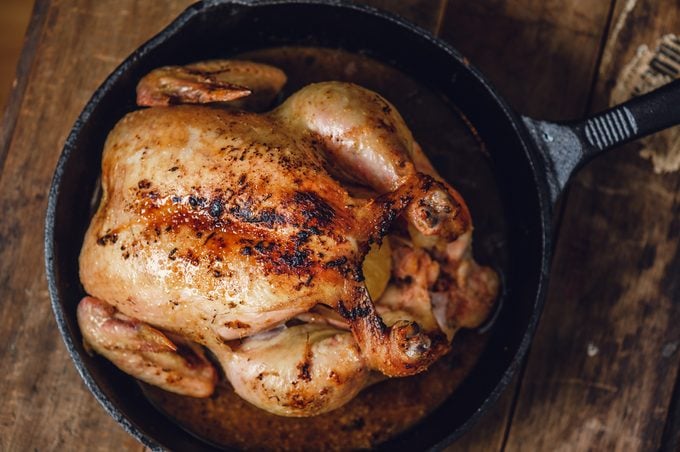The Easy Trick to Knowing When Chicken Is Done Cooking
Updated: Nov. 04, 2022
Don't assume your chicken is done just because you followed a recipe.

Chicken is an easy addition to almost any recipe. It’s also a cost-effective protein if you buy and roast a whole chicken instead of buying different cuts. The one tricky thing is making sure the meat isn’t still raw.
Eating under-done chicken, or any meat, could lead to food poisoning from salmonella and E. coli, or other symptoms like stomach pain, vomiting, and fever. Finding the right balance of doneness is challenging, but not impossible. One common tip is to cut into the thickest part of the meat, but if that meat is done, that means smaller or leaner pieces are now overdone.
The easy trick to knowing when chicken is thoroughly cooked is using a thermometer. Test the temperature in the thigh area, near the breast, or the thickest part of the chicken. The United States Department of Agriculture says the internal temperature of all cooked poultry should reach 165 degrees Fahrenheit. Other reports, however, say to cook chicken until it reaches an internal temperature of 160 degrees as it will rise to 165 as it rests. Make sure that your thermometer isn’t touching the bone since that could give you a faulty reading. Thermometers like this one are an essential kitchen staple that is also good for checking other types of meat as well as chicken.
There are a few other hints that chicken isn’t raw anymore—but they shouldn’t be your stand-alone test since they don’t guarantee doneness. Another way to check is by sizing up the bird, since chicken shrinks when it’s cooked. Note, however, that there’s usually less of a size difference in cooked chicken that’s still on the bone. If the chicken shrinks extremely, it’s likely overcooked. Anything pink is also a sign the chicken is probably not safe to eat. This includes pink meat and pink or bloody juices, too. Don’t poke too far down or completely cut the meat to check the juices. Keeping as much of it inside the chicken will avoid drying it out. Don’t miss these 11 cooking mistakes that could make your food toxic.
